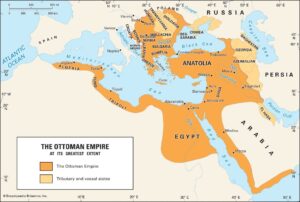c.1300-1923

The Ottoman Empire was one of the largest, long lasting, and influential empires in history.
At its peak, the empire stretched from western North Africa, across eastern Europe to southern Arabia.
OSMAN I (c.1258-1326), tribal chief of Turkmen nomads established the beginning of the Ottoman Empire, named in Arabic after its founder, OSMAN I.
The begging of the Empire was modest. Osman ruled over a relatively small principality in Anatolia, now a part of the country of Turkey.
The Ottomans were descendants of wild, hardy, and ruthless Turkic tribes scattered across central Asia.
Through exposure to Arabic and other people the Ottomans fought and traded with, the Ottomans converted to ISLAM, the rising religion dominant in many Middle East kingdoms.
The Ottomans became zealous converts of Islam and quickly expanded their conquests partly to convert their conquered subjects to Islam.
The existing most powerful empire in the area, the Byzantine Empire, also known as the Eastern Roman Empire presented a challenge to the expansion of the Ottomans conquests as the Byzantines ruled the Middle East, most of Anatolia, south eastern Europe, North Africa and more.
However, the Byzantines were in gradual decline due to lengthy and costly wars with the Sasanian Persians, Bulgars, Arabic kingdoms, Normans, and to internal political upheaval.
The Ottomans quickly took advantage of the gradual decline of the Byzantines and conquered former Byzantine territories until Sultan Mehmed II finally took the Byzantine capital, Constantinople in 1453, thus forever ending the mighty Byzantine Empire.
Constantinople, the largest, most wealthy, and beautiful city in the western world became the new capital of the Empire.

The Ottoman Empire was at its height during the 16th century during the reign of Sultan Suleyman the Magnificent. The Empire now consisted of lands and kingdoms from Africa, Middle East, Southeastern Europe, European Balkans, to the very gates of Vienna.
The Empire was a blend of cultures and peoples. Art, architecture, science, trade, and prosperity flourished. The Ottomans became the biggest trading partner of Western Europe.
The Ottoman sultan was recognized by the large Muslim population in the empire as Caliph, leader of all Islamic faithful.
During the 17th and 18th centuries the Empire slowly grew stagnant, falling behind Western European powers. Constant internal battles over successors to a Sultan, left the Empire leaderless for periods of time. Finances grew scarcer and more unreliable.
As time wore on, the Ottoman Empire began suffering setbacks from rebellious conquered kingdoms and historical enemies such as Russia and Austria-Hungary.
The Balkan territories erupted in rebellion in the late 1800s, early 1900s. Greece, Serbia, Montenegro, and Bulgaria went to war with the Empire for their freedom.
The lost of key territories in Europe along with wars with Russia further weakened the Ottomans.
In 1908 the Young Turk Revolution forced Sultan Abdul Hamid II to re-adopt the defunct Ottoman constitution of 1876 and parliament. Such further internal upheaval allowed rebellious Balkan countries and the European Great Powers to further their political and military aims on the Ottomans.
When World War I erupted in 1914 the Ottomans joined Germany and the Central Powers in their war against the Allies.
The Great War furthered the final collapse of the Empire. Military defeats, revolts and exhausted populace resulted in the surrender of the Central Powers.


